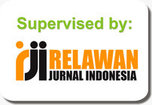Perbandingan LSTM dengan Support Vector Machine dan Multinomial Na ve Bayes pada Klasifikasi Kategori Hoax
Abstract
Hoax is fake news, now massively spread through social media. The impact of hoaxes is that people's misperceptions in understanding of news are very high. With the existence of hoaxes are spreading through social media, it requires the public to think smart when receiving the news. Currently, many ways to prevent hoaxes, right now we have Fact Checker Directory Platform which is a truth platform sourced from several fact check sites. On the truth check platform, every news detected as hoaxes has been categorized into specific type of hoax, manually by the validator. For this reason, this research attempts to automatically categorize the types of hoaxes using comparation of Deep Learning with Machine Learning classifications. Deep Learning uses Long Short Term Memory Network (LSTM), while Machine Learning uses Support Vector Machine (SVM) and Multinomial Naive Bayes. Through the build model process, SVM produces the best accuracy quality of 0.74, Multinomial Na ve Bayes produces an accuracy quality of 0.62 while LSTM displays 0.49. The results of low accuracy in LSTM need to be evaluated on model architecture and data normalization during preprocessing.
Keywords
Full Text:
PDF (Bahasa Indonesia)References
M. Iqbal, “Efektifitas Hukum Dan Upaya Menangkal Hoax sebagai Konsekuensi Negatif Perkembangan Interkasi Manusia,” Literasi Huk., vol. 3, no. 2, pp. 1–9, 2019.
N. Histimuna Aisyah, “Mahasiswa Cerdas Tangkal Berita Hoaks di Era Disrupsi Melalui Literasi Digital,” J. Keislam. dan Ilmu Pendidik., vol. 1, no. 1, pp. 67–82, 2021.
P. W. Cahyo and A. Ulfi Saidata, “Analisis Eksploratif Berita Hoax pada Situs Cek Kebenaran,” J. Inform. Univ. Pamulang, vol. 7, no. 2, pp. 313–320, 2022.
I. M. Solichin, B. N. Jati, F. Ghalib, N. A. Rakhmawati, and A. M. P. Kualitatif, “Analisis Kewaspadaan dan Respon Orang Dewasa terhadap Hoax,” J. Inf. Eng. Educ. Technol., vol. 06, no. 2, pp. 33–36, 2022.
A. Afriza and J. Adisantoso, “Metode Klasifikasi Rocchio untuk Analisis Hoax Rocchio Classification Method for Hoax Analysis,” J. Ilmu Komput. dan Agri-informatika, vol. 5, no. 1, pp. 1–10, 2018.
P. N. Anggreyani and W. Maharani, “Hoax Detection Tweets of the COVID-19 on Twitter Using LSTM- CNN with Word2Vec,” vol. 6, pp. 2432–2437, 2022.
P. W. Cahyo, K. Kusumaningtyas, and U. S. Aesyi, “A User Recommendation Model for Answering Questions on Brainly Platform,” J. INFOTEL, vol. 13, no. 1, pp. 7–12, 2021.
P. W. Cahyo, M. Habibi, A. Priadana, and A. B. Saputra, “Analysis of Popular Hashtags on Instagram Account The Ministry of Health,” in Proceedings of the International Conference on Health and Medical Sciences (AHMS 2020), 2021, vol. 34, no. Ahms 2020, pp. 270–273.
M. Habibi and P. W. Cahyo, “Journal Classification Based on Abstract Using Cosine Similarity and Support Vector Machine,” JISKa, vol. 4, no. 3, pp. 185–192, 2020.
Y. Hacohen-kerner, D. Miller, and Y. Yigal, “The influence of preprocessing on text classification using a bag-of-words representation,” PLoS One, vol. 15, no. 5, pp. 1–22, 2020.
P. W. Cahyo and M. Habibi, “Entity Profiling to Identify Actor Involvement in Topics of Social Media Content,” IJCCS (Indonesian J. Comput. Cybern. Syst., vol. 14, no. 4, pp. 417–428, 2020.
A. Yadav, C. K. Jha, and A. Sharan, “Optimizing LSTM for time series prediction in Indian stock market,” Procedia Comput. Sci., vol. 167, pp. 2091–2100, 2020.
A. Khumaidi, R. Raafi, and I. P. Solihin, “Pengujian Algoritma Long Short Term Memory untuk Prediksi Kualitas Udara dan Suhu Kota Bandung,” J. Telemat., vol. 15, no. 1, pp. 13–18, 2020.
S. Dobilas, “LSTM Recurrent Neural Networks — How to Teach a Network to Remember the Past,” towardsdatascience.com, 2022.
DOI: http://dx.doi.org/10.26623/transformatika.v20i2.5880
Refbacks
- There are currently no refbacks.
| View My Stats |
Jurnal Transformatika : Journal Information Technology by Department of Information Technology, Faculty of Information Technology and Communication, Semarang University is licensed under a Creative Commons Attribution 4.0 International License.









